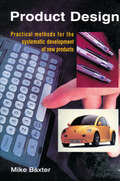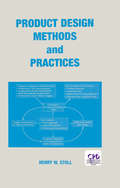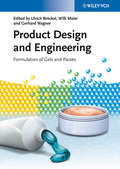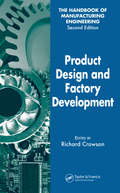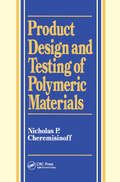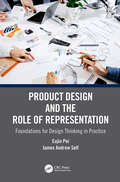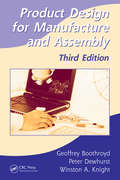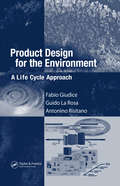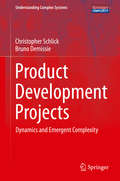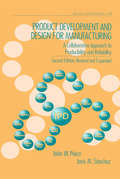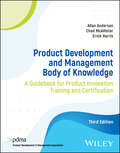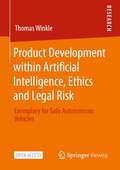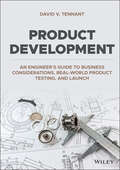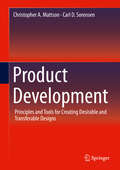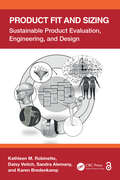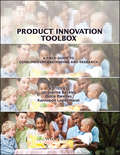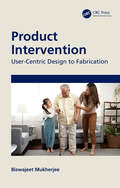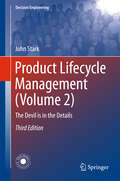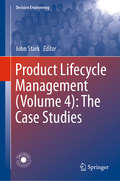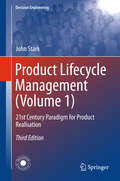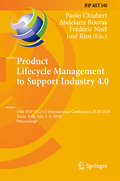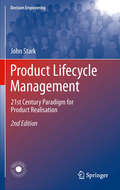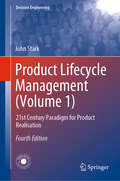- Table View
- List View
Product Design (Design Toolkits Ser.)
by Mike BaxterThe discovery of market needs and the manufacture of a product to meet those needs are integral parts of the same process. Since most textbooks on new product development are written from either a marketing or an engineering perspective, it is important for students to encounter these two aspects of product development together in a single text.Product Design: Practical Methods for the Systematic Development of New Products covers the entire new product development process, from market research through concept design, embodiment design, design for manufacture, and product launch. Systematic and practical in its approach, the text offers both a structured management framework for product development and an extensive range of specific design methods. Chapters feature "Design Toolkits" that provide detailed guidance on systematic design methods, present examples with familiar products, and conclude with reviews of key concepts.This major text aims to turn the often haphazard and unstructured product design process into a quality-controlled, streamlined, and manageable procedure. It is ideal for students of engineering, design, and technology on their path to designing new products.
Product Design Methods and Practices
by Henry W. Stoll"Focuses on functional, aesthetically pleasing, mechanically reliable, and easily made products that improve profitability for manufacturers and provide long-term satisfaction for customers. Offers concrete, practical insight immediately applicable to new product design and development projects."
Product Design and Engineering
by Gerhard Wagner Ulrich Bröckel Willi MeierCovering the whole value chain - from product requirements and properties via process technologies and equipment to real-world applications - this reference represents a comprehensive overview of the topic. The editors and majority of the authors are members of the European Federation of Chemical Engineering, with backgrounds from academia as well as industry. Therefore, this multifaceted area is highlighted from different angles: essential physico-chemical background, latest measurement and prediction techniques, and numerous applications from cosmetic up to food industry.Recommended reading for process, pharma and chemical engineers, chemists in industry, and those working in the pharmaceutical, food, cosmetics, dyes and pigments industries.
Product Design and Factory Development
by Richard CrowsonToday's fast-paced manufacturing culture demands a handbook that provides how-to, no-holds-barred, no-frills information. Completely revised and updated, the Handbook of Manufacturing Engineering is now presented in four volumes. Keeping the same general format as the first edition, this second edition not only provides more information but makes i
Product Design and Testing of Polymeric Materials
by Louise FerranteProduct Design and Testing of Polymeric Materials integrates polymer science principles with detailed experimental programs—helping engineers create optimal products. Thoroughly investigating both physical and processing properties of polymeric substances, this valuable guide presents the philosophy of product development management … includes test methods for base property and end-use performance … pairs viscometric and small-scale testing with molecular properties for processing advantages … examines quality control from the laboratory to the marketplace … applies the mechanics of experimental design to product optimization problems … covers the mathematics needed for proper regression of experimental data … and much more. Product Design and Testing of Polymeric Materials is a complete reference— defining numerous plastics and engineering terms and supplying important data on elastomers and plastics—and is an essential resource for polymer, plastics, and chemical engineers and scientists, materials scientists, and graduate-level students in these disciplines.
Product Design and the Role of Representation: Foundations for Design Thinking in Practice
by Eujin Pei James Andrew Self"This book responds to the expression ‘all you always wanted to know about design representation but didn’t know where to ask’. Indeed, the book is a thematic guide to design representation, and the amount of information about design representations it holds is phenomenal."Professor Gabriela Goldschmidt Technion - Israel Institute of TechnologyThis book extends understanding of the design process by exploring design representation types and examining them as theoretical constructs. It shows how fidelity and ambiguity inform the creative act of design, and considers design thinking through the lens of design representation.Design thinking is a method that has the potential to stimulate and enhance creativity. This book enhances understanding of what constitutes design thinking, why it is used and how it can be applied in practice to explore and develop ideas. The book positions a particular type of thinking through design representations, exploring this from its roots in design history, to the types of thinking in action associated with contemporary design practice. A taxonomy of design representations as a scaffold to express design intent, is applied to real world case studies.Product Design and the Role of Representation will be of interest to those working in or studying product development, engineering design and additive manufacturing.
Product Design for Manufacture and Assembly
by Geoffrey Boothroyd Peter Dewhurst Winston A. KnightHailed as a groundbreaking and important textbook upon its initial publication, the latest iteration of Product Design for Manufacture and Assembly does not rest on those laurels. In addition to the expected updating of data in all chapters, this third edition has been revised to provide a top-notch textbook for university-level courses in product
Product Design for the Environment: A Life Cycle Approach
by Antonino Risitano Fabio Giudice Guido La RosaIn recent years the increased awareness of environmental issues has led to the development of new approaches to product design, known as Design for Environment and Life Cycle Design. Although still considered emerging and in some cases radical, their principles will become, by necessity, the wave of the future in design. A thorough exploration of t
Product Development Projects
by Christopher Schlick Bruno DemissieThis book presents an analysis of the dynamics and the complexity of new product development projects which are organized according to the concept of concurrent engineering. The approach of the authors includes both a theoretical and an empirical treatment of the topic, based on the theory of design structure matrices. Readers will discover diverse perspectives and mathematical models, as well as an extensive discussion of two case studies.
Product Development and Design for Manufacturing: A Collaborative Approach to Producibility and Reliability, Second Edition, (Quality and Reliability)
by Jose Sanchez John Priest"Outlines best practices and demonstrates how to desgin in quality for successful development of hardware and software products. Offers systematic applications failored to particular market environments. Discusses Internet issues, electronic commerce, and supply chain."
Product Development and Management Body of Knowledge: A Guidebook for Product Innovation Training and Certification
by Allan Anderson Chad McAllister Ernie HarrisFully-updated Third Edition of the leading study resource for PDMA's New Product Development Professional certification exam The newly revised and updated Third Edition of PDMA Body of Knowledge (BoK) provides a singular reference for anyone currently involved in, or planning a career in product management and product innovation. It describes a proven framework for product innovation which is applicable to a wide cross-section of product and service industries at various levels of an organization. It is also the basis for candidates studying for PDMA's New Product Development Professional (NPDP) certification examination. The guide is divided into seven chapters, consistent with the seven product innovation topics used as a basis for the NPDP examination: management, strategy, portfolio, process, design and development, market research, and culture & teams. PDMA Body of Knowledge includes detailed coverage of topics including: The key factors that lead to successful product innovation management. The importance of strategy to product innovation success, hierarchy of strategies, and establishing the organization's direction via vision, mission, values, and more. The role of portfolio management in selection of the right product innovation projects for an organization. Description of various product innovation processes and the pros and cons of each. The application of tools and techniques at various stages of the design and development process. The application of market research throughout product innovation. The importance of the right culture and team development. The material provided can be applied to the full range of product development projects included in most company portfolios, such as new products or services, line extensions, cost reductions, and product or service improvements. This newly revised and updated Third Edition includes new case studies, examples, and chapter exercises, along with sample NPDP examination questions. PDMA Body of Knowledge is an essential study resource for those studying for PDMA's NPDP exam. The text is also highly valuable to product management professionals, consultants, instructors, and students seeking to increase their knowledge base
Product Development within Artificial Intelligence, Ethics and Legal Risk: Exemplary for Safe Autonomous Vehicles
by Thomas WinkleThis open-access-book synthesizes a supportive developer checklist considering sustainable Team and agile Project Management in the challenge of Artificial Intelligence and limits of image recognition. The study bases on technical, ethical, and legal requirements with examples concerning autonomous vehicles. As the first of its kind, it analyzes all reported car accidents state wide (1.28 million) over a 10-year period. Integrating of highly sensitive international court rulings and growing consumer expectations make this book a helpful guide for product and team development from initial concept until market launch.
Product Development: An Engineer's Guide to Business Considerations, Real-World Product Testing, and Launch
by David V. TennantPRODUCT DEVELOPMENT An insightful development roadmap to help engineers and businesspeople successfully bring a product to market In Product Development: An Engineer’s Guide to Business Considerations, Real-World Product Testing, and Launch, accomplished project manager, engineer, and business strategist David V. Tennant delivers a comprehensive walkthrough of the full scope of product development activities, from initial business considerations to real-world product testing and launch. The book covers key product development considerations like determining the target market, working with a product development team, management challenges, funding, user identification, ergonomics, product design, testing, and launch. The distinguished author presents the material in the form of practical, hands-on tutorials with case studies featuring large corporations and small- and mid-size firms. He also includes team exercises and question-and-answer features to help early-career and aspiring engineers acquire the interdisciplinary and inter-department coordination skills they’ll require to successfully bring a new product to market. Readers will learn about the critical roles played by the engineering, marketing, and finance departments, as well as each stage of the product development process. The book also includes: Thorough introductions to product development and the role of the marketing group in product development, including corporate strategy, product and business plans, and marketing leadership Comprehensive explorations of the role of the engineering group in product development, including functional areas led by engineers and engineering leadership Practical discussions of the core team and teamwork in product development, including executives’ roles, the role of the accounting department, and the identification of key stakeholders In-depth examinations of how to move forward with product development after project approval Perfect for early- and mid-career engineers working in product-oriented companies, as well as marketers and other business professionals seeking to understand engineering best practices, Product Development is the ideal reference for use in upper-level undergraduate Product Development courses.
Product Development: Principles and Tools for Creating Desirable and Transferable Designs
by Christopher A. Mattson Carl D. SorensenThis book explores the evolution of products from the beginning idea through mass-production. Rather than prescribing a one-size-fits-all process, the authors explain the theory behind product development and challenge readers to develop their own customized development process uniquely suited for their individual situation. In addition to theory, the book provides development case studies, exercises and self-evaluation criteria at the end of each chapter, and a product development reference that introduces a wide variety of design tools and methods. Class-tested for three consecutive years by hundreds of students in four different courses, the book is an ideal text for senior design classes in mechanical engineering and related disciplines as well as a reference for practicing engineers/product designers.
Product Fit and Sizing: Sustainable Product Evaluation, Engineering, and Design
by Kathleen M. Robinette Daisy Veitch Sandra Alemany Karen BredenkampIn this book, for the first time, the complexity of assessing fit and using fittings in the product design process is addressed from a scientific and systems engineering perspective. It includes methods to represent the anthropometry of the target market, good practices to develop protocols for more reliable and consistent fit testing, methods for developing and maintaining a fit database, comprehensive statistical analyses needed for fit and sizing analysis, and instructions for selecting and modeling cases for new product development.Product Fit and Sizing: Sustainable Product Evaluation, Engineering, and Designoffers step-by-step instructions for the evaluation, engineering, and design of existing and new products and includes real-world examples of mass-produced apparel, head wearables, and footwear products. It also explains how to develop a sustainable fit standard for fit and sizing continuity for all styles across all seasons and iterations.This book is intended for industry professionals and undergraduate and graduate education to prepare students for design and engineering jobs. For organizations that purchase uniforms or protective equipment and apparel, it also provides instructions for purchasing professionals to evaluate the suitability of wearable products for their population.The Open Access version of this book, available at http://www.taylorfrancis.com, has been made available under a Creative Commons Attribution-Non Commercial-No Derivatives (CC-BY-NC-ND) 4.0 license.
Product Innovation Toolbox: A Field Guide to Consumer Understanding and Research
by Dulce Paredes Jacqueline H. Beckley Kannapon LopetcharatProduct Innovation Toolbox: A Field Guide to Consumer Understanding and Research brings together key thought-leaders and seasoned consumer researchers from corporate R&D, academia and marketing research companies to share their experiences, cutting edge consumer research tools and practical tips for successful and sustainable product innovation. This is an essential resource for product developers, marketers and technologists who want to implement consumer-centric innovation and are responsible for designing product-testing strategies from upfront innovation to support new product development. The scope of the book by chapter shows the steps that transform a consumer researcher to a Consumer Explorer that guides the project team to successful innovation and new product introductions. Product Innovation Toolbox is designed to appeal to broad audiences from consumer researchers, product developers, marketers and executives. With an emphasis on consumer understanding and examples that range from cheese to lipstick and printers to energy beverages, Product Innovation Toolbox offers guidelines and best practices for strategizing, planning and executing studies with confidence and high efficiency yielding faster and better insights.
Product Innovation Toolbox: A Field Guide to Consumer Understanding and Research
by Dulce Paredes Jacqueline H. Beckley Kannapon LopetcharatPRODUCT INNOVATION TOOLBOX Discover how to implement consumer-centric innovation to help create new product development in this latest edition In recent years, behavioral approaches, social media listening, and other new techniques and technologies—digital techniques, augmented intelligence, machine learning, and advanced biometrics, among others—have been foregrounded in innovation research. A focus on the evolving fields of data science and neuroscience is a driving force for both researchers and the people they study. These digital and mobile technologies have enabled researchers to augment listening, observing and categorizing methods, and to adapt new techniques in attempting to better understand consumers. On the other hand, digitized mobile societies, spurred by faster and cheaper internet access, emphasize an interconnectedness that drastically alters human behaviors and creates borderless influences. Even so, the tenets and approaches to insightful deep learning for consumers and other actors, from discovery through to the launch of successful products, remains an intrinsic part of assessing the market. Product Innovation Toolbox brings together key thought leaders and seasoned consumer researchers from corporate R&D, academia, and marketing research companies to share their experiences, advanced consumer research tools and practical tips for successful and sustainable product innovation. By offering these leading-edge tools and insights, the book ensures consumer-centric innovation by linking strategy and a designed approach. The new edition focuses on the integration and connection of all data—both structured and unstructured???for deep learning and activation, rather than a differentiated qualitative—quantitative approach, reflecting the shifting relationships involved in the latest developments in the field. The second edition of Product Innovation Toolbox also includes: Revised material for more than 70% of the manual, with 11 new and extensively updated chapters New tools sections on digital technologies to create novel ways to stimulate and elicit insights from participants, such as Virtual Reality (VR) and Digital Augmentation Upgraded versions of tools in each updated section, with fresh examples New case studies created using the tools from the previous edition, including cases regarding cross-continental marketplaces and cross-cultural societies An emphasis on tools with global applications Product Innovation Toolbox is an essential resource for product developers, marketers, and technologists.
Product Intervention: User-Centric Design to Fabrication
by Biswajeet MukherjeeThis book covers all aspects of design thinking and its intervention as needed for developing products for the elderly. The book deals with the Universal Principles of Design and how they can be included with Technological Interventions for showcasing the product lifecycle. The main technical features include the Anthropometry calculations, Design Thinking approach on the healthcare products, and selection of target group which is elderly in the presented context. Further, the complete product development cycle, the choice of materials, assessment of the designs, prototyping phases and the final product are all discussed in detail. The various fabrication strategies to reduce the cost of the product, ideation stages and Feedback and Assessment right from design to product development stage are discussed. All the Anthropometry details are included specifically for the target group chosen; its mathematical understanding, error, etc. are all discussed in the book. The ideations, rendering and conceptualization based on Cognitive Ergonomics or Hawthorne and various other effects are also discussed in detail.
Product Lifecycle Management
by John StarkProduct Lifecycle Management (2nd edition) explains what Product Lifecycle Management (PLM) is, and why it's needed. It describes the environment in which products are developed, realised and supported, before looking at the basic components of PLM, such as the product, processes, applications, and people. The final part addresses the implementation of PLM, showing the steps of a project or initiative, and typical activities. This new and expanded edition of Product Lifecycle Management is fully updated to reflect the many advances made in PLM since the release of the first edition. It includes descriptions of PLM technologies and examples of implementation projects in industry. Product Lifecycle Management will broaden the reader's understanding of PLM, nurturing the skills needed to implement PLM successfully and to achieve world-class product performance across the lifecycle. "A 20-year veteran of PLM, I highly recommend this book. A clear and complete overview of PLM from definition to implementation. Everything is there - reasons, resources, strategy, implementation and PLM project management." Achim Heilmann, Manager, Global Technical Publications, Varian Medical Systems "Product Lifecycle Management is an important technology for European industry. This state-of-the art book is a reference for those implementing and researching PLM." Dr. Erastos Filos, Head of Sector "Intelligent Manufacturing Systems", European Commission "This book, written by one of the best experts in this field, is an ideal complement for PLM courses at Bachelor and Master level, as well as a well-founded reference book for practitioners." Prof. Dr.-Ing. Dr. h.c. Sandor Vajna, University of Magdeburg, Germany "This comprehensive book can help drive an understanding of PLM at all levels - from CEOs to CIOs, and from professors to students - that will help this important industry continue to expand and thrive." James Heppelmann, President and Chief Executive Officer, PTC "PLM is a mission-critical decision-making system leveraged by the world's most innovative companies to transform their process of innovation on a continuous basis. That is a powerful value proposition in a world where the challenge is to get better products to the market faster than ever before. That is the power of PLM." Tony Affuso, Chairman and CEO, Siemens PLM Software
Product Lifecycle Management (Decision Engineering)
by John StarkThis book presents some twenty case studies, showing how companies in different industry sectors and of different sizes make advances in Product Lifecycle Management (PLM). Like the author’s previous volumes, this book provides a valuable resource for those wishing to learn about PLM and how to implement and apply it in their companies. Helping readers to · learn about implementing and benefiting from PLM;· learn about good PLM solutions and best practice;· improve their planning and decision-making abilities;· benefit from the lessons learned by the companies featured in the case studies; · proceed faster and further with PLM the book presents effective PLM solutions and best practices. At the same time, the case studies included demonstrate how different companies implement and benefit from PLM. Each case study is addressed in a separate chapter and details a different situation, enabling readers to put themselves in the situation and think through different actions and decisions. A valuable resource for PLM team managers and employees in engineering and manufacturing companies, the book is also of interest to researchers and students in industrial engineering fields.
Product Lifecycle Management (PLM): A Digital Journey Using Industrial Internet of Things (IIoT)
by Uthayan ElangovanProduct Lifecycle Management (PLM): A Digital Journey Using Industrial Internet of Things (IIot) provides a summary of the essential topics of Product Lifecycle Management (PLM) and the Industrial Internet of Things (IIoT) in the era of Industry 4.0. The book discusses emerging technologies, their contribution towards enhancing product design, development, and manufacturing. It also presents the integration of PLM, Enterprise Resource Planning (ERP), and Manufacturing Execution System (MES) along with IIoT as well the integration of mechanical, electronic components, embedded systems, firmware and software focusing on smart design, development, and manufacturing in the digital transformation journey. The book provides a high-level overview of how the smart product development through smart manufacturing materializes within the smart ecosystem. Manufacturing professionals, designers, mechanical, electrical, electronics, instrumentation and industrial engineers, information and communication technology consultants and those working in production planning, process control, and operations will find this book invaluable.
Product Lifecycle Management (Volume #1)
by John StarkThis third edition updates and adds to the successful second edition and gives the reader a thorough description of PLM, providing them with a full understanding of the theory and the practical skills to implement PLM within their own business environment. This new and expanded edition is fully updated to reflect the many technological and management advances made in PLM since the release of the second edition. Describing the environment in which products are developed, manufactured and supported, before addressing the Five Pillars of PLM: business processes, product data, PLM applications, Organisational Change Management (OCM) and Project Management, this book explains what Product Lifecycle Management is, and why it's needed. The final part of the book addresses the PLM timeline, showing the typical steps and activities of a PLM project or initiative. "Product Lifecycle Management" will broaden the reader's understanding of PLM, nurturing the skills needed to implement PLM successfully and to achieve world-class product performance across the lifecycle.
Product Lifecycle Management to Support Industry 4.0: 15th Ifip Wg 5. 1 International Conference, Plm 2018, Turin, Italy, July 2-4, 2018, Proceedings (IFIP Advances in Information and Communication Technology #540)
by Abdelaziz Bouras José Ríos Paolo Chiabert Frédéric NoëlThis book constitutes the refereed post-conference proceedings of the 15th IFIP WG 5.1 International Conference on Product Lifecycle Management, PLM 2018, held in Turin, Spain, in July 2018.The 72 revised full papers presented were carefully reviewed and selected from 82 submissions. The papers are organized in the following topical sections: building information modeling; collaborative environments and new product development; PLM for digital factories and cyber physical systems; ontologies and data models; education in the field of industry 4.0; product-service systems and smart products; lean organization for industry 4.0; knowledge management and information sharing; PLM infrastructure and implementation; PLM maturity, implementation and adoption; 3D printing and additive manufacturing; and modular design and products and configuration and change management.
Product Lifecycle Management: 21st Century Paradigm for Product Realisation
by John StarkProduct Lifecycle Management (2nd edition) explains what Product Lifecycle Management (PLM) is, and why it's needed. It describes the environment in which products are developed, realised and supported, before looking at the basic components of PLM, such as the product, processes, applications, and people. The final part addresses the implementation of PLM, showing the steps of a project or initiative, and typical activities. This new and expanded edition of Product Lifecycle Management is fully updated to reflect the many advances made in PLM since the release of the first edition. It includes descriptions of PLM technologies and examples of implementation projects in industry. Product Lifecycle Management will broaden the reader's understanding of PLM, nurturing the skills needed to implement PLM successfully and to achieve world-class product performance across the lifecycle. "A 20-year veteran of PLM, I highly recommend this book. A clear and complete overview of PLM from definition to implementation. Everything is there - reasons, resources, strategy, implementation and PLM project management." Achim Heilmann, Manager, Global Technical Publications, Varian Medical Systems "Product Lifecycle Management is an important technology for European industry. This state-of-the art book is a reference for those implementing and researching PLM." Dr. Erastos Filos, Head of Sector "Intelligent Manufacturing Systems", European Commission "This book, written by one of the best experts in this field, is an ideal complement for PLM courses at Bachelor and Master level, as well as a well-founded reference book for practitioners." Prof. Dr.-Ing. Dr. h.c. Sandor Vajna, University of Magdeburg, Germany "This comprehensive book can help drive an understanding of PLM at all levels - from CEOs to CIOs, and from professors to students - that will help this important industry continue to expand and thrive." James Heppelmann, President and Chief Executive Officer, PTC "PLM is a mission-critical decision-making system leveraged by the world's most innovative companies to transform their process of innovation on a continuous basis. That is a powerful value proposition in a world where the challenge is to get better products to the market faster than ever before. That is the power of PLM." Tony Affuso, Chairman and CEO, Siemens PLM Software
Product Lifecycle Management: 21st Century Paradigm for Product Realisation (Decision Engineering)
by John StarkThis fourth edition of the book provides readers with a detailed explanation of PLM, enabling them to gain a full understanding and the know-how to implement PLM within their own business environment. This new and expanded edition has been fully updated to reflect the numerous technological and management advances made in PLM since the release of the third edition in 2014, including chapters on both the Internet of Things and Industry 4.0. The book describes the environment in which products are ideated, developed, manufactured, supported and retired before addressing the main components of PLM and PLM Initiatives. These include product-related business processes, product data, product data management (PDM) systems, other PLM applications, best practices, company objectives and organisation. Key activities in PLM Initiatives include Organisational Change Management (OCM) and Project Management. Lastly, it addresses the PLM Initiative, showing the typical steps and activities of a PLM project or initiative. Enhancing readers’ understanding of PLM, the book enables them to develop the skills needed to implement PLM successfully and achieve world-class product performance across the lifecycle.
